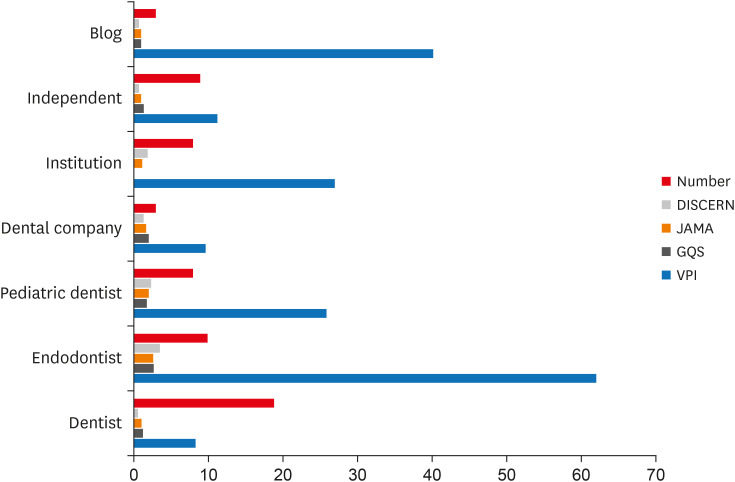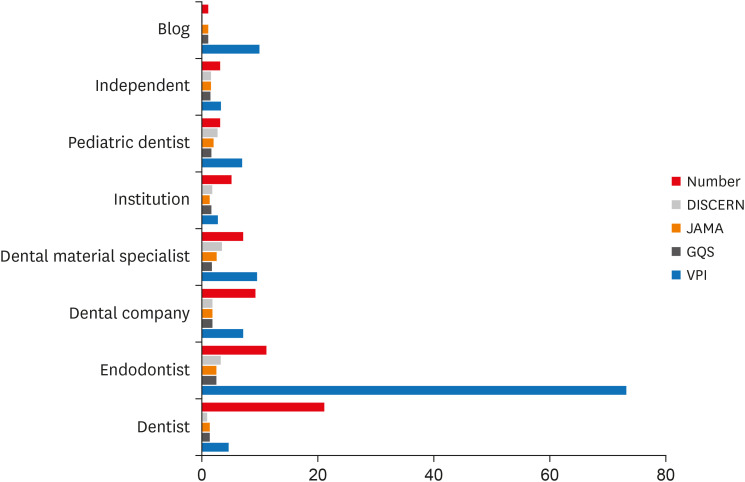Restor Dent Endod.
2021 Aug;46(3):e40. 10.5395/rde.2021.46.e40.
YouTube as a source of information about pulpotomy and pulp capping: a cross sectional reliability analysis
- Affiliations
-
- 1Department of Endodontology, School of Dentistry, Aristotle University of Thessaloniki, Thessaloniki, Greece
- 2Department of Dentoalveolar Surgery, Surgical Implantology & Radiology, School of Dentistry, Aristotle University of Thessaloniki, Thessaloniki, Greece
- KMID: 2548084
- DOI: http://doi.org/10.5395/rde.2021.46.e40
Abstract
Objectives
The purpose of this study was to critically evaluate the quality, reliability and educational content of the information of vital pulp treatment videos available on YouTube.
Materials and Methods
The keywords “pulpotomy” and “pulp capping” were searched on YouTube on 5th July 2020, until 60 English language videos of each search term with a duration shorter than 15 minutes were acquired. Video characteristics were recorded and Video Power Index (VPI) was calculated. Reliability and educational quality of videos were evaluated using the Modified DISCERN score, the Journal of American Medical Association (JAMA) benchmark criteria and Global Quality Scores (GQS). Videos were categorized by uploading source.
Results
Regarding pulpotomy, 31.7% of the videos were uploaded by specialists and 68.3% were directed by non-specialists. In the case of pulp capping, the corresponding percentages were 45% and 55%, respectively. Videos uploaded by specialists had significantly higher modified DISCERN, JAMA and GQS scores compared to those uploaded by non-specialists. Endodontists tended to have the highest reliability and VPI scores.
Conclusions
YouTube videos on vital pulp treatment contain low educational quality or incomplete information. Low popularity of dental pulp capping and pulpotomy videos may be attributed to the specialized nature of these procedures. As YouTube represents an important source for patient information about different health topics, reliable informative videos should be uploaded by specialized dental professionals.
Figure
Reference
-
1. Parashos P, Messer HH. The diffusion of innovation in dentistry: a review using rotary nickel-titanium technology as an example. Oral Surg Oral Med Oral Pathol Oral Radiol Endod. 2006; 101:395–401. PMID: 16504875.
Article2. Rogers EM. Diffusion of innovations. 5th ed. New York, NY: Free Press;2003.3. AlFaris E, Irfan F, Ponnamperuma G, Jamal A, Van der Vleuten C, Al Maflehi N, Al-Qeas S, Alenezi A, Alrowaished M, Alsalman R, Ahmed AM. The pattern of social media use and its association with academic performance among medical students. Med Teach. 2018; 40(Supplement 1):S77–S82. PMID: 29732945.
Article4. Rapp AK, Healy MG, Charlton ME, Keith JN, Rosenbaum ME, Kapadia MR. YouTube is the most frequently used educational video source for surgical preparation. J Surg Educ. 2016; 73:1072–1076. PMID: 27316383.
Article5. Tackett S, Slinn K, Marshall T, Gaglani S, Waldman V, Desai R. medical education videos for the world: an analysis of viewing patterns for a YouTube channel. Acad Med. 2018; 93:1150–1156. PMID: 29298180.
Article6. Wiid J, Cant MC, Nell C. Open distance learning students' perception of the use of social media networking systems as an educational tool. IBER. 2013; 12:867–882.
Article7. Fox S, Purcell K. Chronic disease and the internet [Internet]. Washington, D.C.: Pew Research Center;2010. Updated 2020 Jul 12. Available from: www.pewinternet.org/2010/03/24/chronic-disease-and-the-internet/.8. Bujnowska-Fedak MM, Waligóra J, Mastalerz-Migas A. The internet as a source of health information and services. Adv Exp Med Biol. 2019; 1211:1–16. PMID: 31273574.
Article9. Bujnowska-Fedak MM, Węgierek P. The impact of online health information on patient health behaviours and making decisions concerning health. Int J Environ Res Public Health. 2020; 17:880.
Article10. Madathil KC, Rivera-Rodriguez AJ, Greenstein JS, Gramopadhye AK. Healthcare information on YouTube: a systematic review. Health Informatics J. 2015; 21:173–194. PMID: 24670899.
Article11. Nason GJ, Kelly P, Kelly ME, Burke MJ, Aslam A, Giri SK, Flood HD. YouTube as an educational tool regarding male urethral catheterization. Scand J Urol. 2015; 49:189–192. PMID: 25363608.
Article12. Nason K, Donnelly A, Duncan HF. YouTube as a patient-information source for root canal treatment. Int Endod J. 2016; 49:1194–1200. PMID: 26551481.
Article13. Radonjic A, Fat Hing NN, Harlock J, Naji F. YouTube as a source of patient information for abdominal aortic aneurysms. J Vasc Surg. 2020; 71:637–644. PMID: 31611104.
Article14. Ng CH, Lim GR, Fong W. Quality of English-language videos on YouTube as a source of information on systemic lupus erythematosus. Int J Rheum Dis. 2020; 23:1636–1644. PMID: 32406201.
Article15. Erdem MN, Karaca S. Evaluating the accuracy and quality of the information in kyphosis videos shared on YouTube. Spine. 2018; 43:E1334–EE1339. PMID: 29664816.
Article16. Eksi Ozsoy H. Evaluation of YouTube videos about smile design using the DISCERN tool and Journal of the American Medical Association benchmarks. J Prosthet Dent. 2021; 125:151–154. PMID: 32085870.
Article17. BroadbandSearch.net. Average daily time on YouTube [Internet]. Updated 2021. Available from: https://www.broadbandsearch.net/blog/average-daily-time-on-social-media#post-navigation-4.18. Abukaraky A, Hamdan AA, Ameera MN, Nasief M, Hassona Y. Quality of YouTube TM videos on dental implants. Med Oral Patol Oral Cir Bucal. 2018; 23:e463–ee468. PMID: 29924766.
Article19. Fortuna G, Schiavo JH, Aria M, Mignogna MD, Klasser GD. The usefulness of YouTube™ videos as a source of information on burning mouth syndrome. J Oral Rehabil. 2019; 46:657–665. PMID: 30919986.
Article20. Hassona Y, Taimeh D, Marahleh A, Scully C. YouTube as a source of information on mouth (oral) cancer. Oral Dis. 2016; 22:202–208. PMID: 26718020.
Article21. Hutchison CM, Cave V, Walshaw EG, Burns B, Park C. YouTube™ as a source for patient education about the management of dental avulsion injuries. Dent Traumatol. 2020; 36:207–211. PMID: 31606932.
Article22. Gaş S, Zincir ÖÖ, Bozkurt AP. Are YouTube videos useful for patients \xc4\xb1nterested in botulinum toxin for bruxism? J Oral Maxillofac Surg. 2019; 77:1776–1783. PMID: 31077674.
Article23. Crespo-Gallardo I, Hay-Levytska O, Martín-González J, Jiménez-Sánchez MC, Sánchez-Domínguez B, Segura-Egea JJ. Criteria and treatment decisions in the management of deep caries lesions: Is there endodontic overtreatment? J Clin Exp Dent. 2018; 10:e751–ee760. PMID: 30305872.
Article24. Croft K, Kervanto-Seppälä S, Stangvaltaite L, Kerosuo E. Management of deep carious lesions and pulps exposed during carious tissue removal in adults: a questionnaire study among dentists in Finland. Clin Oral Investig. 2019; 23:1271–1280.
Article25. Özdal Zincir Ö, Bozkurt AP, Gaş S. Potential patient education of YouTube videos related to wisdom tooth surgical removal. J Craniofac Surg. 2019; 30:e481–ee484. PMID: 31299822.
Article26. Hegarty E, Campbell C, Grammatopoulos E, DiBiase AT, Sherriff M, Cobourne MT. YouTube™ as an information resource for orthognathic surgery. J Orthod. 2017; 44:90–96. PMID: 28463076.
Article27. Lena Y, Dindaroğlu F. Lingual orthodontic treatment: a YouTube™ video analysis. Angle Orthod. 2018; 88:208–214. PMID: 29257704.
Article
- Full Text Links
- Actions
-
Cited
- CITED
-
- Close
- Share
- Similar articles
-
- Histological Study of Reparative Dentin Formation after Direct Pulp Capping and Pulpotomy using MTA
- Comparison of Partial Pulpotomy in Permanent Molars Using Different Pulp Capping Agents and Restoration Materials
- Impaction of permanent canine caused by unsuccessful primary canine pulpotomy: a case report
- YouTube as a source of patient education information for elbow ulnar collateral ligament injuries: a quality control content analysis
- YouTube as a source of information about rubber dam: quality and content analysis



